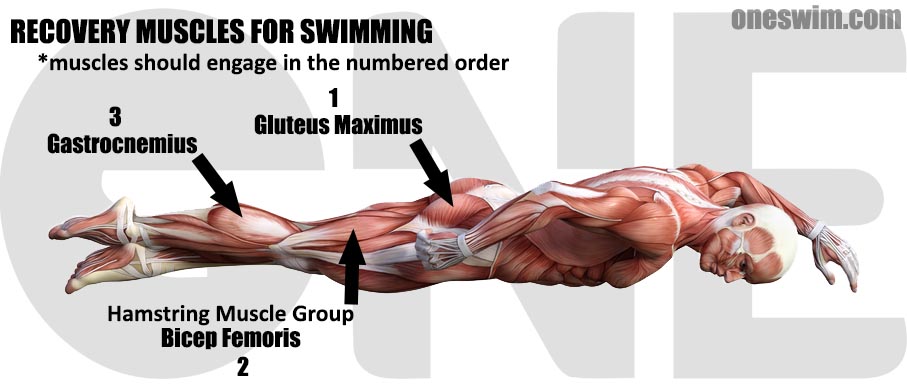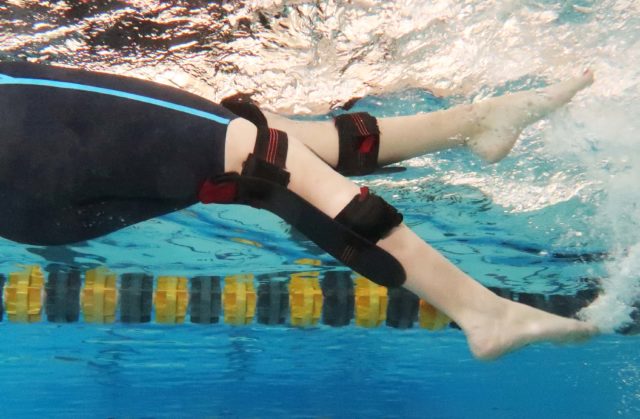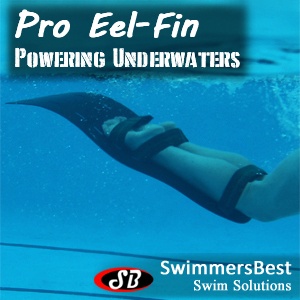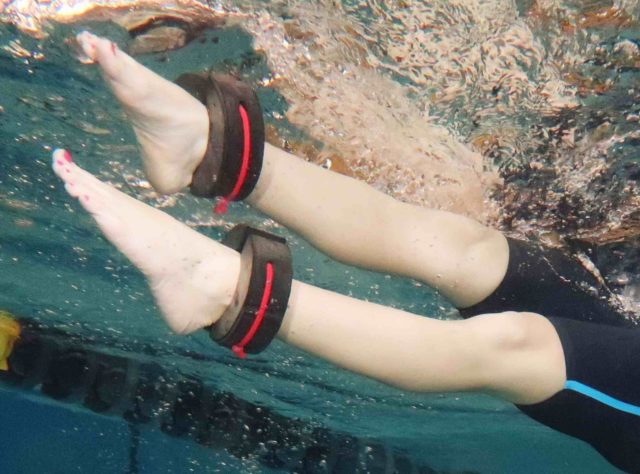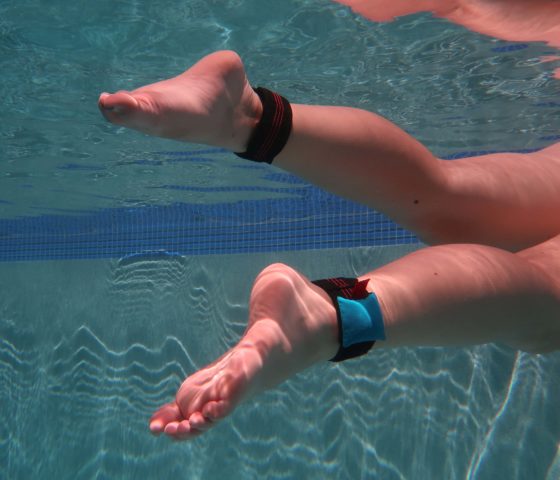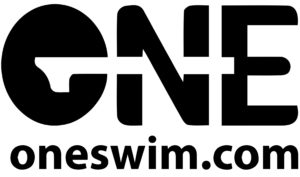courtesy of ONEswim.com, a SwimmersBest brand
Historically (and incorrectly) the swim industry has defined our kick muscles as either ‘propulsive’ (i.e kicking a football) or ‘recovery’ (i.e a donkey kick). However, modern science continues to show that our ‘recovery’ muscle chain can provide over 30% of our leg propulsion.
It is arguable that our recovery muscle chain can provide over 40% of our propulsion if these muscles are engaged and developed correctly. The problem is most modern swim training methods continue to neglect the optimum development of these muscles. The ‘recovery’ chain can greatly improve our speed for our underwater undulations as well as all 4 of our strokes. For the underwater undulations, the ‘propulsive’ phase of our undulation sets up a vortex wave and the recovering feet engage power off that vortex.
So what are our ‘recovery’ muscles and how do we develop them properly?
Roughly, the muscles required to engage our kick ‘recovery’ includes our glutes (Gluteus maximus), hamstrings muscle group (bicep femoris), and calve muscles (gastrocnemius). Most swimmers learn early on to ‘bend at the knee’ by engaging the hamstring and calve muscle groups, but this crucially bypasses the engagement of the glute muscles. The problem of not engaging the glutes logically develops because as swimmers first learn to swim, their calves and hamstrings are the only muscles that are viable at first. We first learn to swim by using the muscles we have available and neglect to develop and build a proper kick that starts from the glutes.
As our glutes slowly develop over time as swimmers, we continue to neglect to learn HOW to engage them properly.
As we advance in our swimming skills and speed, it is critical that we learn how to engage all of our recovery muscle chain in the proper order. The first muscle we fire should be our glutes, followed by the hamstrings and lastly our calves. But very few swimmers actually engage their glutes at all. If we don’t rethink and retrain ourselves to engage the glutes FIRST, we will never fully optimize our recovery power. Due to ‘muscle memory’ there are very few drills we can do to engage our glutes first in the recovery chain. And it is nearly impossible to just ‘tell yourself’ to engage the glutes first.
The end result is that we should be ‘recovering’ our legs without any knee bend and with a straight ankle (the propulsive phase of our kick will have some knee bend). To understand this as it relates to your own kick method, lay flat on the floor with your arms to your side, lift 1 leg without ANY knee bend, then lift the other… then lift both legs at the same time. To lift your legs without any knee bend will require glute engagement first in the muscle chain. Doing this when tired with water resistance is the final goal and therefore we need ways to build and develop a ‘glute engaged’ recovery kick.
Ways to develop a ‘glute engaged’ recovery kick:
ONE – Restrict the initial bending of the knee.
The FlexRight product by ONEswim.com is a flat plastic panel that attaches behind the knee. This still allows for the knee to bend for things like flip turns, but is resistive enough that it trains the glute to engage first. This is ideal for kicking on all sides (back, stomach, or on side) for kick drills or swim drills. Use these for ‘on the back flow’ drills (on back body dolphin) on a daily basis. Similarly, the FlexRIght is also ideal to engage the core muscles for butterfly strokes and underwater undulations.
TWO – Increase surface area beyond the feet.
Normal mono-fins that attach at the ankles actually make our ‘glute engagement’ problems far WORSE because they encourage us to relax our ankles on the recovery to ‘slice’ the monofin through the water. The Pro Eel-Fin by ONEswim.com is a mono-fin that locks the ankles straight to create a very large surface area off the ends of the feet. The Pro Eel-fin (also available in junior size) will force maximum engagement of the glutes for any recovery and when used with a tempo trainer can quickly help create a bi-lateral undulation for your underwaters. To build the core muscles while training the engagements of the glutes, use the Pro Eel-Fin for ‘on the back flow’ on the surface of the water on a regular basis as part of your warm-up program.
THREE – Add Flotation to the Ankles.
Another unique product you don’t know about are Single Ankle Buoys by ONEswim.com. These buoys wrap around each ankle to allow independent kick or can acts as a dual-ankle buoy. When you kick on your back with ankle floats, the flotation will assist in the leg’s upward (‘propulsive) direction but force you to engage your recovery from the glutes in order to recruit the power needed for a straight leg down kick. Equally the Single Ankle Buoys can be used for ‘on the back flow’ (on back body dolphin) in the same way and additionally engage the core muscles.
FOUR – Add Ankle Weights.
Weights help defy gravity so if you add just ½ lb or more of weights (from ONEswim.com) to each ankle and you kick on your stomach, gravity will help the leg during the propulsive phase but resist the recovery phase, helping to build the glute engagement of the leg recovery muscle chain. These are best when used on the stomach for developing recovery muscles. When using ankle weights on your back kick, you develop your propulsive phase muscles.
Do you like our swim education and gear? Join our newsletter.
ABOUT ONESWIM.COM, A SWIMMERSBEST BRAND
ONEswim.com is leading the way for the future of swim training equipment. The company offers a broad range of solutions for improving stroke technique, kick technique, and breathing technique. They provide swimmers, coaches, and teams with the tools they need to balance technique training with conditioning training. By combining the best drills with the best tools, the SwimmersBest products give swimmers instant tactile feedback so they can adjust their technique efficiently. The old way of having coaches constantly remind swimmers of their individual problems has proven to offer very little improvement in technique. All SwimmersBest products are designed to constantly ‘talk to the swimmers’ so they can feel the problems and make corrections. This unique approach means the swimmers are given negative feedback for incorrect stroke technique, which compels the swimmers to quickly correct the problem on their own. With a constant flow of new innovative product designs, SwimmersBest is a company that will continue to deliver solutions you need.
SWIMMERSBEST WEBSITE
SWIMMERSBEST FACEBACK
SWIMMERSBEST TWITTER
SWIMMERSBEST YOUTUBE
SWIMMERSBEST INSTAGRAM
ONEswim.com / SwimmersBest is a SwimSwam partner.
